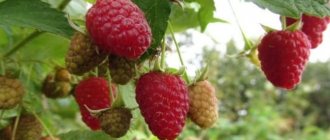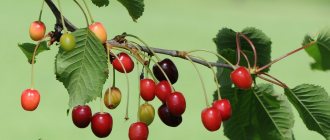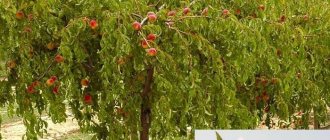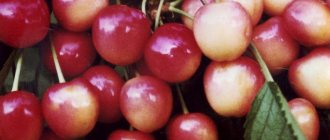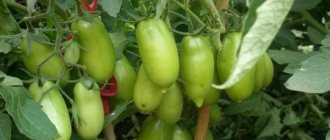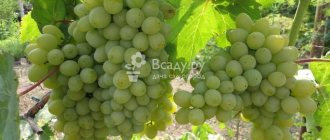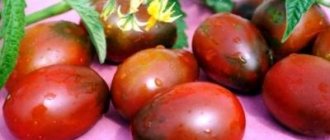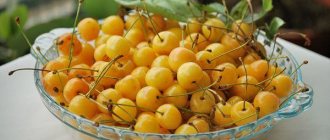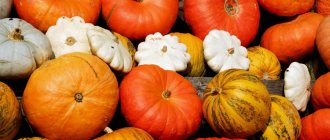The Revna cherry variety is one of the most popular among gardeners in our country. This popularity is explained by the frost resistance of the variety, combined with the excellent taste of the berries and high yield. This is a domestic variety, so it is adapted for cultivation in the Russian climate, including in the middle zone.
In the article we will look at the features of this wonderful type of cherry: we will find out the external and productive characteristics of Revna, we will learn how to plant a tree and how to care for it. Let's also get acquainted with the reviews of gardeners who are already cultivating this variety.
Description of the cherry variety Revna
The tree in this case is of medium size and height: that is, harvesting is quite convenient. The young seedling grows at a rapid pace, slowing down after the age of five. The crown is pyramidal, like many other cherry varieties. It is not very dense, which is very beneficial in terms of light transmission and pest prevention.
In the photo - Revna cherries:
Cherry jealousy
The plant has large dark leaves, which, however, do not create a strong thickening. The fruits weigh between 4.7 and 7.7 grams, have a round shape, and shiny, dark red skin. The pulp is very juicy, colored burgundy. The berries taste very pleasant: they have repeatedly received 4.9 points on a five-point scale at exhibitions. Such a high taste result is achieved due to the high sugar content in the pulp and the unique low acid content.
The tree trunk and branches are resistant to frost and sunburn. In addition, they tolerate low temperatures and buds well, which is important for growing cherries in regions with frequent return frosts.
The Revna variety is not distinguished by early fruiting: the berries are usually harvested for the first time in the fifth year after rooting. However, it’s worth waiting that long: the variety has a high yield. From one tree you can collect, on average, about 30 kg of berries.
The video shows a description of the cherry variety:
The advantages include the following characteristics:
- resistance to fungus;
- wonderful taste of fruits;
- frost resistance;
- high transportability;
- bountiful harvests.
Revna has only two disadvantages: low early pregnancy and lack of self-fertility. And if the first problem is solved by the patience of the gardener, then the second is by planting suitable pollinating trees nearby.
Diseases and pests
Much to the regret of gardeners, cherry fruits attract various birds: starlings, thrushes, tits, sparrows, jays. There are several ways to help protect crops from birds:
- You can hang some rustling elements on the branches. For example, cellophane bags or tapes from old cassette tapes. Shiny objects also have the same effect: New Year's rain, foil, computer disks.
- The cherries can be covered with a fine mesh net. Birds will not be able to destroy the berries, and the tree will receive enough light.
- Installing special repellers that produce high-frequency sounds will also help protect the harvest.
- The desired effect can be achieved by spraying with tincture of hot red pepper. But after rain, this treatment must be repeated. Place 10 pepper pods in 3 liters of water, leave for 3 days, then spray the tree.
Table: diseases characteristic of the Revna variety
| Diseases | Symptoms | Treatment methods | Prevention |
| Gum treatment | On the trunk of the affected tree, gum is released, which hardens and becomes like glass. |
| Sheltering a tree before winter. |
| Hole spot |
| The diseases cannot be treated; affected trees are uprooted and burned. |
|
| Mosaic |
|
Photo gallery: typical cultural diseases
Hole spot causes berries to dry out in affected areas
Gum depletion depletes cherries, worsening yields
Cherry mosaic leads to complete death of the tree
Table: cherry pests
| Pests | Signs | Ways to fight | Prevention measures |
| cherry fly |
| Spraying at the end of April or early May with Iskra (1 tablet per 10 liters of water). | Timely collection of berries (reduces the number of larvae). |
| Cherry shoot moth | Caterpillars eat buds, ovaries and leaves. | Treatment in April, then after flowering with Iskra or Kimix (1 ampoule per 10 l). | Autumn digging of the soil under the cherry tree. |
| Fruit moth | The pest completely eats the leaves, leaving only bare branches. | ||
| Cherry aphid | The larvae feed on the sap of the leaves, after which the plates curl and dry out. | Use of the drugs Inta-Vir (1 tablet per 10 l) and Actellik (10 ml per 10 l of water). | Removal of root shoots in summer. |
| Winter moth |
| Spraying before the formation of buds with Karbofos (60 g per 8 l of water) or Dendrobacillin (50 g per 10 l). | Digging the soil in the tree trunk circle. |
Photo gallery: common crop parasites
The cherry fly is the most common parasite of cherry and sweet cherry trees.
Cherry shoot moth damages the buds, flowers, and leaves of cherries and cherries.
Cherry aphids are a dangerous pest of stone fruits that can deprive crops.
The winter moth eats the leaves, depleting the tree
Fruit moth can completely destroy foliage
How to plant a tree - recommendations for summer residents
Let's look at the features of planting the Revna cherry variety.
Pollinators
In order for a tree to bear fruit abundantly, it needs pollinators. It is better to choose trees of other varieties for this purpose, such as:
- And the way;
- Rechitsa;
- Tyutchevka;
- Raditsa.
The distance between trees should be about 3 meters.
Selection of seedlings
When purchasing a cherry seedling, pay attention to its root system: it must be fully developed. In addition, the number and condition of skeletal branches is very important: a healthy and promising seedling will have at least 3-5 such branches.
Moreover, the branches should grow in different directions, otherwise there is a danger of them breaking in the future under the weight of the berries. One-year and two-year-old seedlings are best suited for rooting. Their height should be 80 and 100 cm.
Place
Choose a sunny area of the garden for Revna, well protected from the winds. The best option is open space facing south or southwest. A small hill is good for rooting a tree. However, it is not advisable to plant it on a high hill, since in this case the tree will be torn to pieces by the winds.
Priming
Cherries will grow and bear fruit best in a sandy or loamy substrate. It is important that groundwater does not lie too close to the surface, since Revna does not tolerate high humidity.
Dense clayey, heavily sandy, and peaty soils are not suitable for growing this variety.
Time
The best period for rooting Revna seedlings is March-April. Choose the time before the buds swell.
Soil preparation
Although the seedling is rooted in the spring, it is necessary to prepare the soil and hole in the fall. First of all, to do this, dig a hole measuring 60x80 cm. A stake is driven into its center for subsequent gartering of the young seedling.
The dug hole is filled one third with a mixture of humus and turf soil. In addition, 300 grams of superphosphate and sodium sulfate in an amount of 100 grams are added to the resulting mixture. Mineral fertilizers should be thoroughly mixed with the soil.
Thus, the pit remains overwintered until spring. By the time the seedling is placed in the hole, the soil in it will already be nutritious and fertile, saturated with the applied fertilizers.
Advantages and disadvantages of the variety
The main advantages of culture:
- fleshy sweet fruits;
- the bone is easily separated from the pulp;
- resistance to temperature changes and frost;
- the crop survives transportation;
- immunity to fungal diseases.
The main inconvenience in growing the variety is its inability to self-pollinate, so pollinating trees are planted nearby. Late fruiting in comparison with other varieties is also noted as a disadvantage.
Planting process
In the spring, a mound of earth is poured into a pre-dug hole, on which the seedling is placed, straightening its roots. After this, the seedling is covered with soil and immediately watered with one or two buckets of water. It is important to mulch the soil around the root circle to provide more moisture to the roots and also protect the plant from weeds.
The root collar of the seedling should rise above the surface of the earth by about 5-6 cm. In no case should it be buried or covered with earth.
After watering and mulching, the seedling is tied to a stake. Please note that it should be located to the north of the seedling so as not to block the latter’s sun. It is also worth learning more about the Bull's Heart cherry and the features of its planting.
The video shows the correct planting of cherries:
Features of care
Let's find out how to care for Revna cherries growing in the garden.
Top dressing
Cherries of this variety require mandatory additional nutrition.
In the first year, no fertilizing is applied, since the soil is “charged” with nutrients when planting, but in the second year it is already necessary to start feeding the plant. In the second and third years of life, the plant is fed with urea so that the tree quickly forms a spreading, abundant crown. And in the fourth and fifth years, ammophosphate and superphosphate are applied under the tree.
Watering
The plant does not tolerate either waterlogged soil or drying out. Sweet cherries need constantly moderately moist soil. The standard treatment regimen for a young tree is 2-3 per month, but if the summer is too dry, you can water it 4 times.
As an adult, Revna cherries need to be watered several times a season. Typically watering is done:
- at the end of May;
- in mid-June;
- once in July;
- in the fall before the onset of frost (moisture-recharging irrigation).
When watering one young tree, you need to use a couple of buckets of water. As the plant matures, one bucket is added every year.
If there are daily and heavy rains, it is recommended to dig out drainage outlets for moisture so as not to create swampy conditions for the tree.
The best way to water cherries is to supply water directly to the tree trunk area. But to do this, it is necessary to dig a shallow furrow along the diameter of this circle, into which to pour water. After the moistening procedure, the soil around the tree needs to be mulched: the mulch layer should be about 10 cm.
In autumn: in September-October, moisture-recharging watering of the tree is carried out. This is done in order to provide the roots with the best conditions for wintering. With this watering, at least 50-60 liters of water are poured under the tree in one procedure.
It is also worth learning more about the description of the Iput cherry, and this is necessary to understand the issue when choosing a tree for planting.
But this information will help you figure out how to save cherries from aphids, and which means are most suitable.
You may also be interested in information about how to plant black prince cherries: //gidfermer.com/sadovodstvo/yagody/chereshnya-chernyj-princ-opisanie-sorta.html
It will also be useful to learn about the existing description of the Napoleon cherry.
Characteristics
The table shows the main characteristic features of the Revna cherry variety.
| Parameter | Meaning |
| Type of crop | Fruit stone fruit tree |
| Height, m | Until 3 |
| Bark | Burgundy brown |
| Crown | Pyramidal |
| foliage | Average |
| Leaves | Large, leathery, dark green, round with a sharp tip. The edge is sharply serrated. |
| Escapes | Fast growing, straight |
| Fruit | Medium, dark red in color, rounded-flattened in shape. Berry weight is 4.5–4.7 g, rarely up to 7 g. |
| Pulp | Dense, dark red |
| Taste | Sweet, tasting rating – 4.9 out of 5 |
| Bone | Easily separated from the pulp, medium size |
| Purpose of the variety | Universal |
| Transportability | good |
Drought resistance, winter hardiness
Winter hardiness was one of the priorities when developing the Revna cherry variety. The result was good. The tree can withstand frosts down to -30 degrees Celsius without any problems.
Revna's drought resistance is quite high. However, regular watering of trees is still necessary, especially during the period of fruit set and ripening.
Pollination, flowering period and ripening time
The Revna cherry blossoms quite early. In different regions, the flowering time is different; in the middle zone it occurs in mid-May.
Revna is considered a partially self-fertile variety, but without neighboring pollinating trees the harvest will be small. Therefore, cherries are usually planted in groups. The varieties Iput, Tyutchevka or Ovstuzhenka are most often planted as pollinators.
Cherry Revna is a mid-late variety. Typically, 2.5 months pass from the moment of flowering until the berries are ready for picking. Good sunny weather can speed up this process. Usually the harvest ripens by the end of July.
Productivity, fruiting
Revna cherries begin to bear fruit in the 5th year. Its productivity is stable, annual and quite high. On average, it is 15–20 kg per tree, and with good care - 30 kg of berries or more. The fruits are not large in size, but they have a beautiful presentation and rarely crack. The thick peel allows the berries to withstand transportation without problems.
Area of application of berries
Revna cherries have an excellent sweet taste and are most often consumed fresh. However, they can also be used to prepare compotes, as well as preserves, confiture, and jams. The high sugar content (almost 13%) makes this berry suitable for home winemaking.
Resistance to diseases and pests
Cherry Revna gets sick relatively rarely. Mostly, diseases appear when care rules are violated (thickening of the crown, excessive watering) or in conditions of high moisture content. The biggest pests of cherries are birds, which love to feast on ripe berries (in everyday life, cherries are often called “bird cherries”). The most common insects that appear on trees are weevils and aphids.
Advantages and disadvantages
Revna cherries have few disadvantages. The most significant of them is the late entry into fruiting, which occurs only in the 5th year. Compared to other varieties of cherries, Revna ripens relatively late, many gardeners consider this a negative side. Another disadvantage is the need for pollinators to obtain a good harvest.
The positive aspects of Revna cherries include:
- Small tree size and compact crown.
- Good winter hardiness.
- Immunity to many fungal diseases.
- Excellent fruit taste and versatility.
- High transportability of the crop.
It should also be noted that the Revna cherry bears fruit annually and consistently, without requiring special care.
Trimming
Cherry Revna needs regular pruning. A young tree needs to trim its branches and shoots every year to form its skeleton and set the correct shape. The tree is pruned for the first time in the second year after planting: this procedure must be carried out in the spring. For plants of any age, spring sanitary pruning is important, when dry, damaged and diseased branches are removed. But how the Fatezh cherry variety is pruned, and how exactly this happens, is indicated in the article at the link.
Video of tree pruning:
As a rule, the pruning procedure is carried out in spring and autumn: before and after the growing season. If you did not have time to trim the branches in the fall, you can carry out the procedure in the winter. However, this should be done only if absolutely necessary, since due to the low temperature the cuts will be uneven, and wounds do not heal well in the cold.
How to prepare cherries for winter
The Revna cherry variety, reviews, descriptions and characteristics of which were discussed above, as already mentioned, is frost-resistant. But in order for the tree to better withstand the cold, it should still be carefully prepared for winter. In autumn, cherries definitely need to be bleached. It is also worth removing diseased branches from the tree. Cherries will withstand cold weather better even if intensive autumn fertilizer is applied to its root zone. Also, the tree trunk circle should be covered with a thick layer of peat. It is especially important to carry out this procedure for young trees.
Wintering
Although the variety is positioned as frost-resistant, however, this does not mean that in any cold weather you can leave cherries without shelter and preparation.
We list the main measures that will help the tree safely survive the harsh Russian winter. In October, it is necessary to remove moss, lichens and dead bark from the trunk and skeletal branches. This is done in order to prevent pests from overwintering in these layers. The trunk of the plant is whitened with lime with the addition of copper sulfate and wood glue. Then the area near the trunk is covered with peat or sawdust (mulched) with a layer of 20 cm. The trunk and skeletal branches at the base are covered with thick paper. But what wintering cherries is like, Valery Chkalov will help you understand this description.
Gardeners' opinion about the variety
Cherry Revna (variety description, photos, reviews - everything speaks of this more than convincingly) is a productive and unpretentious plant. And therefore, it is certainly advisable to grow it on your country plot. The berries of this cherry, according to all gardeners without exception, are distinguished by simply wonderful taste. Moreover, their skin is very thick. Therefore, they can be transported safely even over long distances. These cherries ripen quite quickly and never crack. Many summer residents also really like the fact that the pulp of its berries is very juicy, but quite dense and fits well to the seed.
According to many gardeners, this cherry is simply ideal for central Russia. She tolerates winters well. Its branches almost never freeze. The same goes for the kidneys. This variety is not affected by all kinds of fungal diseases, which significantly saves the summer resident’s time.
Harvesting
You can harvest young cherries from the end of June to the first half of July.
From one tree usually 15 to 30 kg of berries are harvested. It is recommended to pick the berries before they are fully ripe: this measure will increase the transportability of the product if you are growing Revna for sale. The layer of berries in the storage container should not exceed 5 cm, otherwise the lower fruits will begin to crush.
Revna makes wonderfully tasty preparations: preserves, jellies, jams, marmalade, liqueurs, etc. But, of course, the berry is incredibly tasty and healthy even when eaten fresh. But how rich the harvest of the Ovstuzhenka cherry variety is, and how well the tree bears fruit, is indicated here.
History of the variety's creation
This cherry, like a number of other varieties, was bred at the end of the last quarter of the last century by breeders from the All-Russian Research Institute of Lupine, located in the Bryansk region. The authors of this variety are famous breeders M.V. Kanshina and A.I. Astakhov, who have been breeding different varieties of fruit trees for decades.
When breeding Revna, the Bryansk pink variety was taken as a basis, and free pollination was carried out. As a result, a new variety of cherries was obtained, the name of which was given in honor of the river flowing in the Bryansk region.
Varietal tests were carried out in the 90s, and in 1994 the fruit tree was included in the Russian State Register.
Reviews
Let's get acquainted with some reviews from gardeners who grow Revna cherries on their plots.
- Svetlana, Yeisk: “We have several varieties of cherries growing in our garden. Several years ago we planted Revna, and now this variety is our favorite. It's easy to care for and survives the winter well even without shelter - it's warm here. The taste of the berries is incomparable: very sweet, dessert-like, the whole family and friends are delighted. We sell the surplus on the market - the berries lie well, do not deform, and do not flow. I recommend this variety as unpretentious and quite productive.”
- Olga, Lipetsk: “The Revna cherry variety has been growing in my dacha for 10 years. Fruits after the age of five every year. The yields are stable and good. I really like the taste of the berries: soft, sweet, they make excellent preparations. Maintenance is simple, but pruning and fertilizing are very important. It endures the winter with a bang, without any problems at all, the lower branches don’t even freeze.”
And here you can read reviews about Tyutchevka cherries, as well as learn more about this type of tree.
We looked at the characteristics of the Revna cherry variety. As you can see, the variety has much more advantages than disadvantages. It is not surprising that Revna is one of the most beloved cherry varieties by domestic gardeners. Now you can grow this amazing plant on your plot and enjoy high yields of delicious, juicy berries.
What other advantages does it have?
The description of popular varieties of cherries (Revna is no exception in this regard) involves, first of all, a detailed consideration of all their pros and cons. The variety we are considering, in addition to winter hardiness, has many advantages. First of all, summer residents include the following benefits of Revna cherries:
- excellent taste of the fruit;
- good transportability;
- resistance to sunburn;
- high productivity.
This variety is also highly valued by gardeners because, unlike most other varieties of cherries, it is not damaged by spring frosts. This is explained simply. The Revna cherry blossoms quite late.
